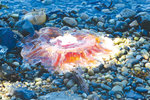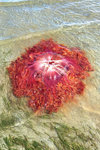

A mass stranding of lion’s mane jellyfish shocked Key Peninsula beach walkers during the second week of August — and made swimmers think twice about getting in the water.
“I have never seen so many in all my life,” said third-generation Home resident Leila Luginbill. She counted over 70 near the Home boat ramp. Most of the stranded jellies were 1.5 to 2 feet in diameter.
The full extent of the stranding is unknown, with reports coming from Von Geldern Cove and Glen Cove. A 1,000-foot stretch of beach south of Glen Cove had 214 jellyfish — over half a ton of gelatinous biomass. Dion and Greg Rurik found one measuring 3 feet across.
“Red jellyfish were abundant on the north, west, and south shores of Von Geldern Cove August 6,” said Lakebay resident Ron Cameron. “There were many over 2 feet in diameter and up to 3 feet, and several inches thick.”
Cameron also said that his wife Carol, who grew up at Hermosa Beach in Tulalip west of Marysville, remembered seeing them thick on the August beaches there during her childhood.
The lion’s mane is believed to be the largest jellyfish in the world, with some Arctic specimens growing to 8 feet in diameter and hauling a mass of tentacles over 100 feet long. Its sting, designed to subdue small fish and crustaceans, can be compared to an extended wasp sting — strong enough to give swimmers a miserable time but hardly lethal. It lives in northern oceans around the world, and on the Washington coast ranging as far south as Oregon.
Those stranded right-side up looked like a clear circle of jelly suffused with blood red in the center. Those stranded upside down revealed something of the eight lobes and circles and spokes of musculature that enable them to swim using rudimentary sensory organs that detect changes in orientation and light. Perhaps swim is too strong a word, for even the biggest jellyfish are more or less at the mercy of currents and wind.
They are fragile, said Rachel Easton of Harbor WildWatch. When they hit anything hard, like a beach, they just die.
Yet many of these were likely dead on arrival. Jellyfish have an annual life cycle, with adults beginning to die and disintegrate in late summer.
Like many weedy plants, jellyfish are poised to take advantage when conditions favor them. Their life cycle starts with a polyp attached to a rock or other hard surface undersea. In spring this polyp clones itself over and over, sending tiny medusae into a free-drifting life. By midsummer the survivors have grown to serving platter size, their growth made possible by the fact that they lack hard parts and are 95% water. The males send sperm into the sea, the females gather it and brood their eggs internally, and the babies — smaller than the head of a pin — swim to the bottom to become a polyp.
Luginbill said she remembers tossing moon jellies around with her brothers as a child. Once in a while, she said, they would find a yellow-centered egg yolk jellyfish. Lion’s mane were almost unheard of. “One would be a spectacular event, but this — they are all up and down the beach, frying in the sun, poor things.”
Like many residents, Luginbill found it hard not to speculate about the cause. Among marine biologists it has been widely speculated that jellyfish will thrive in future oceans as they warm and acidify, potentially outcompeting many fish.
While it is normal for jellyfish to bloom and die in large numbers, researchers at projects like the Global Jellyfish Group are trying to determine if blooms are getting larger and more frequent, as has often been reported in the scientific press. It has been hypothesized that a number of human impacts on the ocean would benefit jellyfish, including overfishing of competitors, zooplankton blooms caused by fertilizer runoff, warming water, and the proliferation of pilings that give the jellyfish’s anchored polyp phase more places to live.
Yet the picture is not clear. Several studies suggest that, like anchovy and sardine, many jellyfish species fluctuate regularly in population, with cycles in the 20-year range.
Worldwide data has only been gathered in the last 15 years. In Puget Sound, several researchers have attempted to cobble together data from scientific trawls and have potentially found a pattern of increasing jellyfish numbers in South Puget Sound, but all agree that far more data is needed to predict any trends.
Jellyfish can be disruptive by discouraging water-based recreation and tourism. They clog fishing nets and hamper aquaculture. They have also been known to shut down nuclear plants by clogging the intakes of water cooling systems.
UNDERWRITTEN BY THE FUND FOR NONPROFIT NEWS (NEWSMATCH) AT THE MIAMI FOUNDATION, THE ANGEL GUILD, ADVERTISERS, DONORS AND PEOPLE WHO SUPPORT INDEPENDENT, NONPROFIT LOCAL NEWS